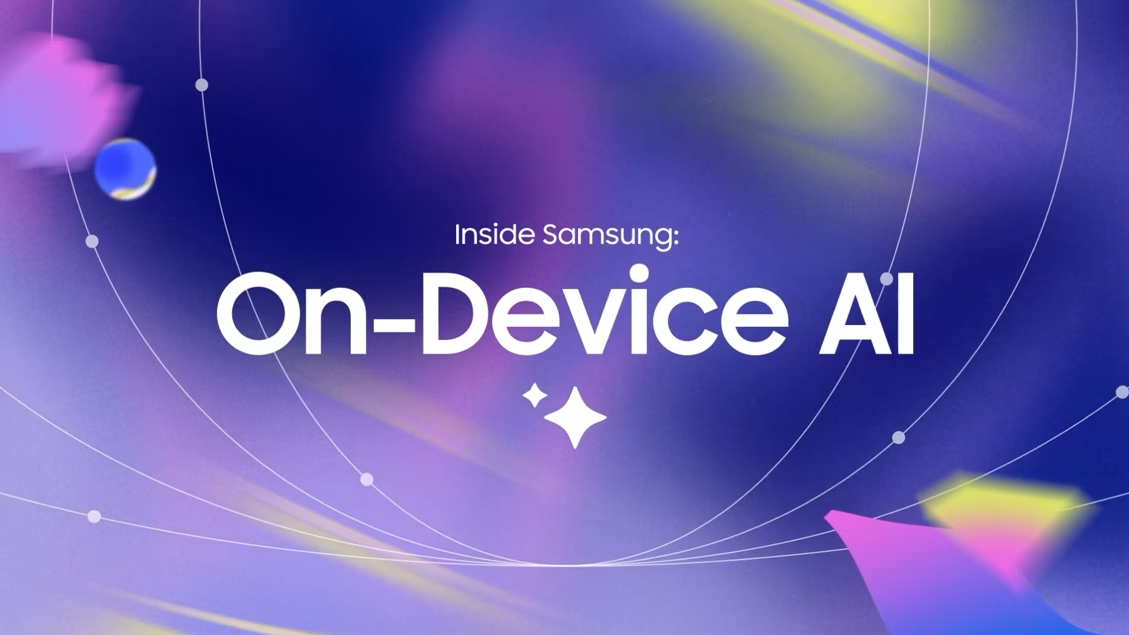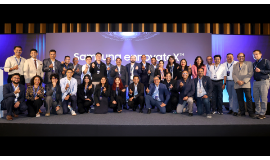 Play
Play
Artificial Intelligence
Artificial intelligence (AI) technology is poised to become increasingly integral to our daily lives, facilitating interactions with smart devices through chat, speech, gestures, and various cues. These advancements will significantly enhance the efficiency of our routines both at home and in the workplace, highlighting the necessity of operating these technologies in a secure and safe manner.
Under the vision of "AI for All," Samsung plans to integrate AI services across all product lines, enabling users to enjoy a more convenient and enriched daily life. At Samsung Research, our mission is to develop innovative AI solutions that enrich the customer experience for the billions of users and devices under the Samsung brand. We are committed to shaping a new era of connected living with AI, creating entirely new experiences and values tailored for users. Our principles emphasize being user-centric, always safe, always helpful, and always learning, with a focus on fairness, accountability, and transparency.
We focus on developing device AI methodologies while incorporating a range of applied AI techniques. We strive to enable seamless interaction between users and Samsung devices, ensuring a smooth experience amid the complexities of modern technology. Our work also extends to developing multimodal agentic systems through the integration of speech recognition, language comprehension, and visual understanding technologies.
Our goal is to enhance the intelligence of generative AI models through extensive research in large language models (LLMs) and code models. Our commitment includes building reliable models and services using technologies such as reinforcement learning, Retrieval-Augmented Generation (RAG), prompt engineering, and efficient model serving. We tackle fundamental challenges such as integrating learning and perception with high-level knowledge. This approach aims to enhance reasoning capabilities by incorporating the user’s context and domain knowledge. This research not only improves our product competitiveness but also boosts internal productivity .
We develop technologies that provide real-time multilingual translation in various apps such as translation tools, browsers, and Notes within smartphones. Additionally, typical use cases include converting the style of sentences when users write, recommending spelling/grammar, and suggesting appropriate response content.
Our development of voice and sound AI technology aims to achieve a human-like understanding of speech and sounds, facilitating natural conversations and expressions. We are also enhancing listening experiences through advanced analysis and understanding. Our core technologies is the E2E Speech LLM solution, which includes voice-related solutions such as voice recognition, synthesis, and processing, as well as sound recognition, source separation, quality improvement, audio search, and voice biomarker-based Brain health. These technologies enable Samsung devices such as smartphones, home appliances and wearables to offer tailored intelligent services in various settings.
In the case of videos in the smartphone gallery, there are cases where background noise is included, so we develop technologies that can reduce or amplify it. This can be used to search for target audio sources and separate them, like an audio eraser."
As more Samsung devices come equipped with cameras, there is a significant opportunity to transform these from smart to AI-driven devices with the support of vision AI. We aim to provide a comprehensive and on-device vision solutions for Samsung devices, ranging from low-level camera sensor processing to high-level visual intelligence for smartphone and TV.
Photos usually contain various text information, and the technology to recognize this text information has many applications. For example, in the case of a prescription photo, it contains information such as drug names, drugs, and dosages, so it can be registered in an app that automatically manages them. Another example is when signs/menus/newspapers/books contain text, it can perform useful functions such as copying & pasting these texts or searching and translating them. In addition, we develop generative AI technologies such as removing unnecessary objects from photos in the smartphone gallery, and generating wallpaper images that dynamically changes according to the weather and time.

We are developing a generative AI model named Samsung Gauss. This model is inspired by Carl Friedrich Gauss, a renowned mathematician known for formulating the theory of normal distribution, which is crucial in fields like machine learning and AI. Samsung Gauss embodies our aim to harnessing the power of AI to significantly improve consumer lives worldwide.
Samsung Gauss2 offers enhanced performance and efficiency by handling various data types simultaneously as a multimodal model that integrates language, code, and images. It is available in three distinct models designed for different purposes: Compact, Balanced, and Supreme.
• Compact Model: This small-sized model is specifically designed for efficient operation in limited computing environments, maximizing each device's unique capabilities for optimized on-device performance.
• Balanced Model: This model achieves a balance between stability and efficiency, providing consistent performance across a variety of tasks.
• Supreme Model: Aiming for top-tier performance, this model utilizes a new model architecture built upon the Balanced model, enabling significant reductions in computational requirements during training and inference while maintaining high levels of both performance and efficiency.
Samsung Gauss2 supports up to 14 languages as well as various programming languages, depending on the model. To ensure maximum efficiency for these supported languages, Samsung has developed and incorporated its own stabilization techniques for training large language models (LLMs) and designed a custom Tokenizer.
Looking ahead, Samsung aims to continually enhance the performance of its code.i service through Samsung Gauss2, improve the natural language question-and-answer functionality of the Samsung Gauss Portal, and support multimodal features such as understanding tables, charts, and creating images. Each of these enhancements is intended to boost productivity within the company.
※ In Partnership with Bloomberg Media Studios
Principles for AI Ethics
As AI technology unfolds its boundless potential, ushering in a new era of experiences, it simultaneously poses potential social and ethical challenges. To ensure the sustainable and ethical deployment of AI and its applications, we have established the principles of “Fairness,” “Transparency,” and “Accountability.” These guidelines are not just about legal compliance but are a testament to our commitment to social and ethical responsibilities.
To integrate these ethical principles into our corporate culture, they will be embedded into our internal guidelines and training programs. This initiative aims to educate and direct our employees toward the ethical development and use of AI.
-
1. Fairness
Our commitment extends to embedding the values of equality and diversity diversity across the AI system’s entire lifecycle, ensuring that our AI does not perpetuate or amplify negative or unfair biases.
We will make AI accessible to all users, promoting inclusivity. -
2. Transparency
Users will be clearly informed when they are interacting with AI., fostering an environment of trust.
AI will be designed to be explainable, allowing users to comprehend the basis of its decisions or recommendations within the bounds of technological possibility.
The processes involving the collection or use of personal data by AI will be conducted with utmost transparency. -
3. Accountability
We pledge to imbue our AI systems with social and ethical responsibility, reflecting our corporate values.
AI systems will be fortified with robust security measures to safeguard against data breaches and cyberattacks, ensuring user data protection.
Through our AI systems, we aim to contribute to society and enhance our stature as responsible corporate citizens.











































































![[Blog] DIFFSSR: Stereo Image Super-resolution Using Differential Transformer](https://cdn.codeground.org/resources/f327bd49d3/AZo4c6zKALwAUGpU.png)
![[Blog] From Cradle to Cane: A Two-Pass Framework for High-Fidelity Lifespan Face Aging](https://gcg-stage-cdn-v2.stage.codeground.org/resources/e1fb383490/AZp6yHWqAGcAUNVF.png)
![[Blog] Network GDT: GenAI-Based Digital Twin for Automated Network Performance Evaluation](https://gcg-stage-cdn-v2.stage.codeground.org/resources/70b447959c/AZoEW0nKAJgAUNX5.png)
![[Blog] Efficient Compositional Multi-tasking for On-device Large Language Models](https://gcg-stage-cdn-v2.stage.codeground.org/resources/70b447959c/AZoFIabKAKcAUNX5.png)

![[Blog] LoRA.rar: Learning to Merge LoRAs via Hypernetworks for Subject-Style Conditioned Image Generation](https://gcg-stage-cdn-v2.stage.codeground.org/resources/73a75f14e1/AZnquWMaAH0AUNX5.png)
![[Blog] Multi-task Learning for Speech Emotion Recognition in Naturalistic Conditions](https://cdn.codeground.org/resources/73a75f14e1/AZnhn7GaBIIAUGrV.png)

![[Blog] Clustering-based Hard Negative Sampling for Supervised Contrastive Speaker Verification](https://gcg-stage-cdn-v2.stage.codeground.org/resources/f8b8957167/AZl5TDy6ADcAUNXr.png)
![[Blog] SemEval-2025 Task 8: LLM Ensemble Methods for QA over Tabular Data](https://cdn.codeground.org/resources/b80a4e8597/AZkmiJ1aA4UAUGrV.png)
![[Blog] Robust neural codec language modeling with phoneme position prediction for zero-shot TTS](https://gcg-stage-cdn-v2.stage.codeground.org/resources/8edfa9cfff/AZjLwFZqAqEAUNWW.png)
![[Blog] Predicting High-precision Depth on Low-Precision Devices Using 2D Hilbert Curves](https://gcg-stage-cdn-v2.stage.codeground.org/resources/8edfa9cfff/AZjBepL6AnQAUNWW.png)
![[Blog] Fairness in Dysarthric Speech Synthesis: Understanding Intrinsic Bias in Dysarthric Speech Cloning using F5-TTS](https://cdn.codeground.org/resources/a32b0c70ee/AZiXg0-aAn0AUGrV.png)
![[Blog] DreamCache: Finetuning-Free Lightweight Personalized Image Generation via Feature Caching](https://gcg-stage-cdn-v2.stage.codeground.org/resources/6081aa81de/AZdn2a06AHMAUNWW.png)
![[Blog] Edge-SD-SR: Low Latency and Parameter Efficient On-device Super-Resolution with Stable Diffusion via Bidirectional Conditioning](https://gcg-stage-cdn-v2.stage.codeground.org/resources/6081aa81de/AZdivNFKAGQAUNWW.png)
![[Blog] Accurate Scene Text Recognition with Efficient Model Scaling and Cloze Self-Distillation](https://gcg-stage-cdn-v2.stage.codeground.org/resources/6081aa81de/AZdh6mXKAFUAUNWW.png)
![[Blog] VladVA: Discriminative Fine-tuning of LVLMs](https://gcg-stage-cdn-v2.stage.codeground.org/resources/6081aa81de/AZdXoRzaAEAAUNWW.png)
![[Blog] Augmenting Perceptual Super-Resolution via Image Quality Predictors](https://gcg-stage-cdn-v2.stage.codeground.org/resources/6081aa81de/AZdTMC7aADEAUNWW.png)
![[Blog] FAM Diffusion: Frequency and Attention Modulation for High-Resolution Image Generation with Stable Diffusion](https://gcg-stage-cdn-v2.stage.codeground.org/resources/bd4ee23f52/AZc4UkF6AA0AUNWW.png)
![[Blog] From AI Concept to Real World: AI-powered Modem for Next Samsung Cellular Networks](https://gcg-stage-cdn-v2.stage.codeground.org/resources/12b634256a/AZcKJcMqAC8AUNW5.png)
![[Blog] Trick-GS: A Balanced Bag of Tricks for Efficient Gaussian Splatting](https://gcg-stage-cdn-v2.stage.codeground.org/resources/657596d155/AZbWrjWaAA4AUNW5.png)
![[Blog] Exploring Simple Siamese Network for High-Resolution Video Quality Assessment](https://gcg-stage-cdn-v2.stage.codeground.org/resources/bcb3b485a2/AZaEW-gKAC8AUNUY.png)
![[Blog] Unified Arbitrary-Time Video Frame Interpolation and Prediction](https://gcg-stage-cdn-v2.stage.codeground.org/resources/bcb3b485a2/AZaEBMwKACAAUNUY.png)
![[Interview] A New and Enhanced Gallery Experience: How Samsung Transformed Photo Searching and Video Editing With the Galaxy S25 Series](https://gcg-stage-cdn-v2.stage.codeground.org/resources/bcb3b485a2/AZaEcljqAD4AUNUY.png)

![[Blog] AI-Driven Modem Innovations for Shaping the Future RAN](https://cdn.codeground.org/resources/2c339caef2/AZZqJxVaAfsAUGqS.png)
![[Blog] On-device hand model for robust gesture detection](https://cdn.codeground.org/resources/2c339caef2/AZZmx8gKAesAUGqS.png)
![[Blog] OAMaskFlow: Occlusion-Aware Motion Mask for Scene Flow](https://gcg-stage-cdn-v2.stage.codeground.org/resources/c3cb3c6066/AZY3mjIqAU8AUNVK.png)

![[Blog] MambaNext: An Enhanced Backbone Network with Focus Linear Attention](https://gcg-stage-cdn-v2.stage.codeground.org/resources/99ba72f041/AZYPC5z6ASUAUNVK.png)
![[Blog] Globally Normalizing the Transducer for Streaming Speech Recognition](https://gcg-stage-cdn-v2.stage.codeground.org/resources/7627a84697/AZX1ai0aAEcAUF_x.png)

![[Blog] CheapNVS: Real-Time On-Device Novel View Synthesis for Mobile Applications](https://gcg-stage-cdn-v2.stage.codeground.org/resources/3419ee9fbf/AZWsDs06AG4AUNVK.png)
![[Blog] FaceMe: Robust Blind Face Restoration With Personal Identification](https://gcg-stage-cdn-v2.stage.codeground.org/resources/b0d82c4e77/AZRsn6bKADEAUNWH.jpg)
![[Blog] Off-Policy Selection for Optimizing Ad Display Timing in Mobile Games (Samsung Instant Plays)](https://gcg-stage-cdn-v2.stage.codeground.org/resources/b0d82c4e77/AZRnjmz6ADkAUF9I.png)

![[AI Leadership] ③ Samsung's AI Strategy Centered on Customer Experiences](https://gcg-stage-cdn-v2.stage.codeground.org/resources/899506bccb/AZOts63qAOQAUNW-.png)
![[AI Leadership] ① Revolutionizing Everyday Devices Using On-Device AI](https://gcg-stage-cdn-v2.stage.codeground.org/resources/899506bccb/AZOtq-lKANgAUNW-.png)
![[Blog] SOI: Scaling Down Computational Complexity by Estimating Partial States of the Model](https://gcg-stage-cdn-v2.stage.codeground.org/resources/eb26fdb447/AZLST-fqAA8AUF-f.jpg)
![[Blog] Blind Face Video Restoration with Temporal Consistent Generative Prior and Degradation-Aware Prompt](https://cdn.codeground.org/resources/0e21f50298/AZMA5c7qABcAUDub.jpg)
![[Editorial] The New Future Shaped by AI](https://gcg-stage-cdn-v2.stage.codeground.org/resources/16d78fc9a6/AZMYlvq6AAgAUF9I.png)

![[Blog] HIMap: HybrId Representation Learning for End-to-end Vectorized HD Map Construction](https://gcg-stage-cdn-v2.stage.codeground.org/resources/aef0dbd388/AZK4ADb6AggAUNWx.png)
![[Blog] SAMSEMO: New Dataset for Multilingual and Multimodal Emotion Recognition](https://gcg-stage-cdn-v2.stage.codeground.org/resources/5471502d58/AZKS7ZvaAeEAUNWx.png)
![[SDC24] Keynote: A Decade of Innovation and a Journey Toward AI for All](https://gcg-stage-cdn-v2.stage.codeground.org/resources/9149edb6c7/AZJ1RCE6AasAUNWx.png)

![[Blog] A Unified Approach to Multilingual Automatic Speech Recognition with Improved Language Identification for Indic Languages](https://gcg-stage-cdn-v2.stage.codeground.org/resources/b7a7b85e96/AZGdBQn6AOgAUNWx.png)
![[Blog] SummaryMixing makes speech technologies faster and cheaper](https://gcg-stage-cdn-v2.stage.codeground.org/resources/b7a7b85e96/AZGb69daANkAUNWx.png)
![[Blog] Speech Boosting: Low-Latency Live Speech Enhancement for TWS Earbuds](https://gcg-stage-cdn-v2.stage.codeground.org/resources/ecc5c6c552/AZF-D52aAJEAUNWx.png)
![[Blog] Speaker Personalization for Automatic Speech Recognition using Weight-Decomposed Low-Rank Adaptation](https://gcg-stage-cdn-v2.stage.codeground.org/resources/b7a7b85e96/AZGXm2DaANMAUNWx.png)
![[Blog] High Fidelity Text-to-Speech Via Discrete Tokens Using Token Transducer and Group Masked Language Model](https://gcg-stage-cdn-v2.stage.codeground.org/resources/b7a7b85e96/AZGWtJWaAMQAUNWx.png)
![[Blog] NL-ITI: Enhancing LLM Truthfulness Through Internal Modifications](https://gcg-stage-cdn-v2.stage.codeground.org/resources/b7a7b85e96/AZGWRs-qALUAUNWx.png)
![[Blog] Relational Proxy Loss for Audio–Text based Keyword Spotting](https://gcg-stage-cdn-v2.stage.codeground.org/resources/ecc5c6c552/AZF43hcKAHAAUNWx.png)
![[Blog] Handwriting Enhancement: Recognition-Based and Recognition-Independent Approaches for On-device Online Handwritten Text Alignment](https://gcg-stage-cdn-v2.stage.codeground.org/resources/ecc5c6c552/AZFoIAk6ADoAUNWx.png)
![[Blog] Sentimental and Object-Preserving On-Device AI Wallpaper](https://gcg-stage-cdn-v2.stage.codeground.org/resources/95b64463a0/AZFO7o9aAA0AUNWx.png)
![[Blog] UPR-Net: A Unified Pyramid Recurrent Network for Video Frame Interpolation](https://gcg-stage-cdn-v2.stage.codeground.org/resources/23d7e9ae8f/AZEBPgFqAakAUNUW.png)
![[Blog] FT-CSR: Cascaded Frequency-Time Method for Coded Speech Restoration](https://gcg-stage-cdn-v2.stage.codeground.org/resources/d4da518a1d/AZC5AvMKAUMAUNUW.png)
![[Blog] Object-Centric Representation Learning for Video Scene Understanding](https://gcg-stage-cdn-v2.stage.codeground.org/resources/60686145ee/AZCQzE_aAQEAUNUW.png)
![[Blog] A Multi-Stage Framework for Emotion-Cause Pair Extraction in Conversations](https://gcg-stage-cdn-v2.stage.codeground.org/resources/6fad67c0e9/AZCAuC9aAOMAUNUW.png)
![[Blog] Learning Representations from Explainable and Connectionist Approaches for Visual Question Answering](https://gcg-stage-cdn-v2.stage.codeground.org/resources/6fad67c0e9/AZCAfuRqANcAUNUW.png)
![[Blog] MR-VNet: Media Restoration Using Volterra Networks](https://gcg-stage-cdn-v2.stage.codeground.org/resources/d528a0b228/AY__dYWaAG0AUNUW.png)
![[Blog] FFF: Fixing Flawed Foundations in Contrastive Pre-training Results in Very Strong Vision-Language Models](https://gcg-stage-cdn-v2.stage.codeground.org/resources/2deb9d75bf/AY_xJPiqAF4AUNUW.png)

![[Blog] Achievement-based Training Progress Balancing for Multi-Task Learning](https://cdn.codeground.org/resources/2a260e391c/AY-Zh7S6AcEAUGqr.png)

![[Blog] AI Technology's Foray Into The Enchanting World of Video Compression](https://cdn.codeground.org/resources/42b5fb8438/AY9wdFyaAXMAUGqr.jpg)
![[Blog] Robust Speaker Personalisation Using Generalized Low-Rank Adaptation for Automatic Speech Recognition](https://gcg-stage-cdn-v2.stage.codeground.org/resources/9cb288d7c4/AY8UEQS6AQgAUNWM.png)
![[Interview] Fast, Lightweight and On-Device AI: How Samsung Research Built AI Features That Translate in Real Time](https://gcg-stage-cdn-v2.stage.codeground.org/resources/9cb288d7c4/AY8ZBOUqASwAUNWM.png)
![[Blog] A Class-Balanced Soft-Voting System for Detecting Multi-Generator Machine-Generated Text](https://gcg-stage-cdn-v2.stage.codeground.org/resources/9cb288d7c4/AY8OB-fKAQUAUNWM.png)
![[Blog] Dynamic Video Frame Interpolator with Integrated Difficulty Pre-Assessment](https://gcg-stage-cdn-v2.stage.codeground.org/resources/9cb288d7c4/AY8DrPVaANgAUNWM.png)
![[Blog] Towards LLM-Based Automatic Boundary Detection for Human-Machine Mixed Text](https://cdn.codeground.org/resources/9cb288d7c4/AY8O2kKaAQYAUGqr.png)
![[Blog] Enabling Device Control Planning Capabilities of Small Language Model](https://gcg-stage-cdn-v2.stage.codeground.org/resources/5255ff85cd/AY70MkA6ALQAUNWM.png)
![[Blog] FSPEN: An Ultra-Lightweight Network for Real Time Speech Enhancement](https://gcg-stage-cdn-v2.stage.codeground.org/resources/5255ff85cd/AY7uuG_6AIQAUNWM.png)
![[Blog] Latent Filling: Latent Space Data Augmentation for Zero-shot Speech Synthesis](https://gcg-stage-cdn-v2.stage.codeground.org/resources/5255ff85cd/AY7gRsAqAFoAUNWM.png)
![[Blog] MELS-TTS: Multi-Emotion Multi-Lingual Multi-Speaker Text-To-Speech System via Disentangled Style Tokens](https://gcg-stage-cdn-v2.stage.codeground.org/resources/78bfb2e890/AY7Q2_5aAEgAUNWM.png)
![[Blog] A Modular System for Enhanced Robustness of Multimedia Understanding Networks via Deep Parametric Estimation](https://gcg-stage-cdn-v2.stage.codeground.org/resources/78bfb2e890/AY7QDtdKADwAUNWM.png)
![[Blog] Finding Waldo: Towards Efficient Exploration of NeRF Scene Spaces](https://gcg-stage-cdn-v2.stage.codeground.org/resources/dbf69399ae/AY5eRvNqAAcAUJxu.jpg)
![[Blog] Locality Enhanced Dynamic Biasing And Sampling Strategies For Contextual ASR](https://gcg-stage-cdn-v2.stage.codeground.org/resources/5d7a7ba14b/AY4Xj57qAEMAUJwc.png)
![[Blog] Consistency Based Unsupervised ASR Personalisation](https://cdn.codeground.org/resources/5d7a7ba14b/AY4R-MiaAPwAUGrv.png)
![[Blog] Enabling Light-Weight AI-based Positioning by Log Signature Transform of Wireless Channels](https://cdn.codeground.org/resources/5d7a7ba14b/AY4RTMsKAO8AUGrv.png)
![[Blog] Multi-Modal Beam Selection: A Transfer Methodology for Multi-Frequency](https://cdn.codeground.org/resources/5d7a7ba14b/AY4RTnQqAPIAUGrv.png)
![[Blog] Back Transcription as a Method for Evaluating Robustness of Natural Language Understanding Models to Speech Recognition Errors](https://cdn.codeground.org/resources/7b4393058f/AYxXsyTqADIAUGq0.png)

![[Blog] A Model for Every User and Budget: Label-Free and Personalized Mixed-Precision Quantization](https://gcg-stage-cdn-v2.stage.codeground.org/resources/ce68485ddd/AYujgoP6AJAAUF-N.jpg)
![[Blog] Personalized Sound Enhancement: A Journey From Idea To Deployment Into The Hands Of Millions Of Samsung Users](https://cdn.codeground.org/resources/267d1f6371/AYsiiHBaAJwAUGrS.png)
![[Blog] Online Continual Learning in Keyword Spotting for Low-Resource Devices via Pooling High-Order Temporal Statistics](https://gcg-stage-cdn-v2.stage.codeground.org/resources/0fe2dffb4e/AYrKjPLKAFAAUJwU.png)
![[Blog] Hierarchical Timbre-Cadence Speaker Encoder for Zero-shot Speech Synthesis](https://gcg-stage-cdn-v2.stage.codeground.org/resources/6b5fe6aea0/AYqlpDo6ABYAUJwU.png)
![[Blog] A More Accurate Internal Language Model Score Estimation for the Hybrid Autoregressive Transducer](https://gcg-stage-cdn-v2.stage.codeground.org/resources/1dfdca481a/AYqIJ1SaABMAUJxY.png)
![[Blog] Website Clustering via Transformer Context Models](https://gcg-stage-cdn-v2.stage.codeground.org/resources/1d93238549/AYpkSijqABMAUJxO.png)
![[Blog] Multilingual Open Custom Keyword Spotting Testset](https://gcg-stage-cdn-v2.stage.codeground.org/resources/ec2a59b618/AYo_87W6ANYAUJwc.png)
![[Blog] RandMasking Augment: A Simple and Randomized Data Augmentation for Acoustic Scene Classification](https://gcg-stage-cdn-v2.stage.codeground.org/resources/7e17d06ab3/AYmufR96AFIAUJwc.png)
![[Blog] Short-Term Memory Convolutions](https://gcg-stage-cdn-v2.stage.codeground.org/resources/928c695977/AYmVkhhKACIAUJwc.png)
![[Blog] Prompt Based and Cross-Modal Retrieval Enhanced Visual Word Sense Disambiguation](https://cdn.codeground.org/resources/0882a19090/AYlsjB26ACIAUGrH.png)
![[Blog] An AL-R Model for Multilingual Complex Named Entity Recognition](https://gcg-stage-cdn-v2.stage.codeground.org/resources/0882a19090/AYlhGeyaAnAAUJx5.png)
![[Blog] Pretrained Bidirectional Distillation for Machine Translation](https://gcg-stage-cdn-v2.stage.codeground.org/resources/0882a19090/AYlhRY2KAn8AUJx5.png)
![[Blog] Self-Supervised Accent Learning for Under-Resourced Accents Using Native Language Data](https://gcg-stage-cdn-v2.stage.codeground.org/resources/767fd5640f/AYlDeST6Ak0AUJx5.png)
![[Blog] TrickVOS: A Bag of Tricks for Video Object Segmentation](https://gcg-stage-cdn-v2.stage.codeground.org/resources/aa250637db/AYkkWxtKAi8AUJx5.png)
![[Blog] [CVPR 2023 Series #7] Zero-Shot Everything Sketch-Based Image Retrieval, and in Explainable Style](https://gcg-stage-cdn-v2.stage.codeground.org/resources/ee9867a38f/AYhwXFG6APEAUJx5.png)
![[Blog] [CVPR 2023 Series #3] GENIE: Show Me the Data for Quantization](https://cdn.codeground.org/resources/687cffa73a/AYgiczg6ArIAUGpB.png)
![[Blog] Dynamic VFI (Video Frame Interpolation) with Integrated Difficulty Pre-Assessment](https://gcg-stage-cdn-v2.stage.codeground.org/resources/20cb47b57f/AYhF7j-qAKkAUJx5.png)
![[Blog] [CVPR 2023 Series #2] StepFormer: Self-supervised Step Discovery and Localization in Instructional Videos](https://gcg-stage-cdn-v2.stage.codeground.org/resources/687cffa73a/AYgy0yXqAJoAUJx5.png)
![[Blog] GOHSP: A Unified Framework of Graph and Optimization-based Heterogeneous Structured Pruning for Vision Transformer](https://cdn.codeground.org/resources/39171e5849/AYfBxj8aAcQAUGpB.png)
![[Blog] LP-IOANet: Efficient High Resolution Document Shadow Removal](https://gcg-stage-cdn-v2.stage.codeground.org/resources/495bf4b341/AYdGGhL6ARIAUJzb.png)
![[Blog] Multi-Stage Progressive Audio Bandwidth Extension](https://cdn.codeground.org/resources/9c413df04e/AYYubjbKADsAUGou.png)

![[Blog] Enabling Accurate Positioning in NLOS Scenarios by Hybrid Machine Learning with Denoising and Inpainting](https://cdn.codeground.org/resources/cb4aa8fc5c/AYXniFqlCdOMMjyh.png)
![[Blog] FlowFormer: A Transformer Architecture for Optical Flow](https://cdn.codeground.org/resources/69b60dfa01/AYWkuAR1COqMMjyh.png)
![[Blog] FedMargin - Federated Learning via Attentive Margin of Semantic Feature Representations](https://gcg-stage-cdn.codeground.org/resources/7e3de341ef/AYV7LfBaAA0AUJxM.png)
![[Blog] Task Generalizable Spatial and Texture Aware Image Downsizing Network](https://gcg-stage-cdn.codeground.org/resources/9e3eb38e42/AYUKicE6AA0AUJzB.png)
![[Blog] Resolving Privacy-Personalization Paradox](https://gcg-stage-cdn.codeground.org/resources/000be58b2a/AYRPpJpKAAoAUJyX.png)

![[Blog] pMCT - Patched Multi-Condition Training](https://gcg-stage-cdn.codeground.org/resources/b1e847dee7/AYRAxJSKACcAUJzg.png)
![[Blog] [INTERSPEECH 2022 Series #6] Multi-stage Progressive Compression of Conformer Transducer for On-device Speech Recognition](https://gcg-stage-cdn.codeground.org/resources/8f824bcee6/AYPKsqy6ABYAUJxB.png)
![[Blog] [INTERSPEECH 2022 Series #5] Prototypical Speaker-Interference Loss for Target Voice Separation Using Non-Parallel Audio Samples](https://cdn.codeground.org/resources/3f243ebb2f/AYPy1ZARBBynCbf0.png)
![[Blog] Enhanced Bi-directional Motion Estimation for Video Frame Interpolation](https://gcg-stage-cdn.codeground.org/resources/3f243ebb2f/AYPlb2aKABwAUJzt.png)

![[Blog] [INTERSPEECH 2022 Series #3] Bunched LPCNet2: Efficient Neural Vocoders Covering Devices from Cloud to Edge](https://gcg-stage-cdn.codeground.org/resources/5304df37f6/AYOmzQ3qAOEAUJw7.png)
![[Blog] [INTERSPEECH 2022 Series #2]FedNST: Federated Noisy Student Training for Automatic Speech Recognition](https://gcg-stage-cdn.codeground.org/resources/ba54858926/AYOCfXa6ABMAUJwL.png)
![[Blog] [INTERSPEECH 2022 Series #1] Human Sound Classification based on Feature Fusion Method with Air and Bone Conducted Signal](https://cdn.codeground.org/resources/29c3782a9e/AYNiumWGAAZwRz45.png)
![[Blog] Detecting Depression, Anxiety and Mental Stress in One Sequential Model with Multi-task Learning](https://gcg-stage-cdn.codeground.org/resources/7fcb17b6ed/AYJhivwaABwAUJyA.png)
![[Blog] Task-Driven and Experience-Based Question Answering Corpus for In-Home Robot Application in the House3D Virtual Environment](https://gcg-stage-cdn.codeground.org/resources/7fcb17b6ed/AYJhWimqAA0AUJyA.png)
![[Blog] Dynamic Multi-scale Network for Dual-pixel Images Defocus Deblurring with Transformer](https://cdn.codeground.org/resources/7fcb17b6ed/AYJsYBknAMl9a_eJ.png)
![[Blog] [CVPR 2022 Series #6] Gaussian Process Modeling of Approximate Inference Errors for Variational Autoencoders](https://cdn.codeground.org/resources/07c9075560/AYIZdBa0AZgpy3UD.png)
![[Blog] [CVPR 2022 Series #5] P>M>F: The Pre-Training, Meta-Training and Fine-Tuning Pipeline for Few-Shot Learning](https://cdn.codeground.org/resources/e3493f4f3c/AYH0vs-LB3eMogld.png)
![[Blog] [CVPR 2022 Series #2] Day-to-Night Image Synthesis for Training Nighttime Neural ISPs](https://cdn.codeground.org/resources/4f473d9dbf/AYGI4qtLBQSMogld.png)
![[Blog] TFPSNet Time-Frequency Domain Path Scanning Network for Speech Separation](https://cdn.codeground.org/resources/15164441cb/AYFqTiNbBIiMogld.png)
![[Blog] [CVPR 2022 Series #1] Probabilistic Procedure Planning in Instructional Videos](https://cdn.codeground.org/resources/15164441cb/AYFlulvrBHGMogld.jpg)
![[Blog] Extending NNStreamer: Pipeline Framework and Among-Device AI](https://cdn.codeground.org/resources/3a44edd2f3/AYE9UfS7A-eMogld.png)
![[Blog] MetaCC: A Channel Coding Benchmark for Meta-Learning](https://cdn.codeground.org/resources/819e8237ea/AYEitsm7AziMogld.jpg)
![[Blog] Drop-DTW: A Differentiable Method for Sequence Alignment that can Handle Outliers](https://cdn.codeground.org/resources/9d1f64b194/AYDWA52bAo6Mogld.jpg)
![[Blog] Empowering the Telecommunication System with Reinforcement Learning](https://cdn.codeground.org/resources/20ce025d8f/AYAHi3ybAKiMogld.jpg)



![[Blog] Feature Kernel Distillation](https://cdn.codeground.org/resources/20ce025d8f/AYACZjuLAHuMogld.jpg)
![[Blog] Mobile Twin Recognition](https://cdn.codeground.org/resources/6be15cab0a/AX_Y8pkBAxE1eqLi.jpg)
![[Blog] Using sound to add scale to computer vision](https://cdn.codeground.org/resources/51ec03124a/AX--ms0RAsY1eqLi.jpg)

![[Blog] FjORD: Fair and Accurate Federated Learning under heterogeneous targets with Ordered Dropout](https://cdn.codeground.org/resources/d1a2183d62/AX9m6G8hAao1eqLi.jpg)
![[Blog] Smart at what cost? Characterising Mobile DNNs in the wild](https://cdn.codeground.org/resources/d1a2183d62/AX9m6RFRAa01eqLi.jpg)
![[CES 2022] Live Video from Las Vegas](https://cdn.codeground.org/resources/a446422e8b/AX4zPS4lALg1cjiK.png)
![[CES 2022] Video : Virtual Booth Tour](https://cdn.codeground.org/resources/a446422e8b/AX4tyawVAJg1cjiK.jpg)
![[CES 2022] Samsung Research's New Tech Trio ① AI Avatar – Who is he/she?](https://cdn.codeground.org/resources/a446422e8b/AX4tWrcFAHQ1cjiK.jpg)
![[CES 2022] Video : Digital, meet Physical](https://cdn.codeground.org/resources/a446422e8b/AX4turiFAIk1cjiK.jpg)
![[CES 2022] Experts Behind Samsung's Newest Products and Technologies Discuss Innovating for the Future ②](https://cdn.codeground.org/resources/a446422e8b/AX4tIYiFAEM1cjiK.jpg)
![[CES 2022] Samsung Introduces a Futuristic Lifestyle with Innovative Technology, Connecting the Customer Experience at CES 2022](https://cdn.codeground.org/resources/a446422e8b/AX4qEfDFADM1cjiK.jpg)
![[Samsung AI Forum 2021] Advancing AI Technologies That Can Help Humankind](https://cdn.codeground.org/resources/b636905d8e/AXz-PJacAp4UTDHa.jpg)
![[Blog] ASAM: Adaptive Sharpness-Aware Minimization for Scale-Invariant Learning of Deep Neural Networks](https://cdn.codeground.org/nsr/images/img/blog-thumb28-385_280.jpg)
![[Samsung AI Forum 2021] Day 2: Harnessing AI To Improve People's Lives](https://cdn.codeground.org/resources/08e6328c0d/AXzeIok8An0UTDHa.png)


![[Blog] Meta-Learning in Neural Networks](https://cdn.codeground.org/nsr/images/img/blog-thumb23.jpg)
![[Blog] Zero-Cost Neural Architecture Search](https://cdn.codeground.org/nsr/images/img/blog-thumb21.jpg)
![[Blog] Leveraging the Availability of Two Cameras for Illuminant Estimation](https://cdn.codeground.org/nsr/images/img/blog-thumb20.jpg)

![[Blog] Learning to Align Temporal Sequences](https://cdn.codeground.org/resources/46b4cad31a/AXosE_DdAh8rg-js.jpg)


![[Blog] VIDEO SCALENET (VSN) – TOWARDS THE NEXT GENERATION VIDEO STREAMING SERVICE](https://cdn.codeground.org/nsr/images/img/blog-thumb10.jpg)

![[Blog] Towards explainable representations for natural language understanding](https://cdn.codeground.org/resources/1da09f82d2/AXj9OhrNAN8rg-js.jpg)




![[Samsung AI Forum 2020] Day 2: Putting People at the Center of AI Development](https://cdn.codeground.org/resources/912d4d4413/AXWL7kz0AUNnfXKh.jpg)



![[Hearing from an AI Expert – 6] AI and 5G: A Two-Pronged Revolution](https://cdn.codeground.org/resources/c52bd5cfe2/AW4AX7bBAJ80VN17.jpg)
![[Hearing from an AI Expert – 5] At the Intersection of Robotics and Innovation](https://cdn.codeground.org/resources/c6ac631c2f/AW3cqLwxAG80VN17.jpg)
![[Hearing from an AI Expert – 4] On-device AI Breathes Life into IoT](https://cdn.codeground.org/resources/7b18b8d871/AW25GItxAEM0VN17.jpg)
![[Hearing from an AI Expert – 3] Vision is About Understanding the World](https://cdn.codeground.org/resources/852f82fa49/AW2UlSiRAAs0VN17.jpg)
![[Hearing from an AI Expert – 2] How AI Will Change the World](https://cdn.codeground.org/resources/c3ec084573/AW1wnyV5ADJ_R_Xn.jpg)
![[Hearing from an AI Expert – 1] The Age of AI is Coming](https://cdn.codeground.org/resources/9f3a489e56/AW1M8HpOAAJEnATN.jpg)







![[Interview]“With Samsung’s Unique Strengths, We Are Developing a User-Oriented AI Algorithm”](https://cdn.codeground.org/nsr/images/img/researchareas/ai-related-articles-08.png)





